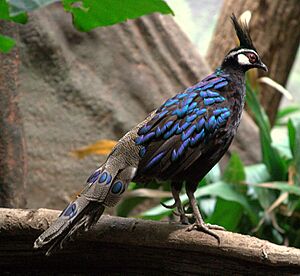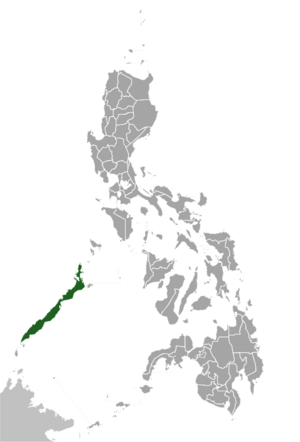Palawan peacock-pheasant facts for kids
Quick facts for kids Palawan peacock-pheasant |
|
|---|---|
 |
|
| Conservation status | |
| Scientific classification | |
| Genus: |
Polyplectron
|
| Species: |
napoleonis
|
 |
|
| Palawan peacock-pheasant range | |
The Palawan peacock-pheasant (scientific name: Polyplectron napoleonis) is a beautiful bird found only on Palawan island in the Philippines. It belongs to the pheasant family, which includes chickens and turkeys. This bird can grow up to 50 centimeters (about 20 inches) long.
Local people on Palawan call this bird tandikan. It is an important part of their culture. The Palawan peacock-pheasant even appears on the official seal of Puerto Princesa, a city on Palawan.
Contents
What Does It Look Like?
Male Palawan Peacock-Pheasant
The male Palawan peacock-pheasant looks a lot like a peacock. It has a special crest on its head that can stand up. Its feathers are super shiny, like electric blue-violet and metallic green-turquoise. Its chest and belly are a soft, velvety black.
The male's tail feathers are wide and flat. They are black on the inside and shiny violet-blue-green on the outside. Each tail feather has bright, reflective "eyes" or spots. These spots are bordered by black and gray. When the male wants to attract a mate, he holds his tail up high. He also spreads it out to show off. He might even lift one wing and lower the other. This display helps him find a partner. It can also scare away predators.
Female Palawan Peacock-Pheasant
The female is a bit smaller than the male. Her feathers are a cloudy, earthy color. This helps her blend in with the ground and branches. Her chest and back are a dark brown.
Like the male, the female has a short crest. She also has white on her throat, cheeks, and above her eyes. Her tail feathers have similar markings to the male's. But her spots are not as bright or eye-catching.
Chicks and Young Birds
Baby Palawan peacock-pheasants are bright orange and brown. They have clear yellow markings. Young birds, both male and female, look like their mothers for their first year. As young males get older, they start to look more like their fathers.
Special Features
Both male Palawan peacock-pheasants have sharp spurs on their legs. Some females also have these spurs. They use these spurs to defend themselves from enemies. They also use them to dig for food in the leaves. Males use them when fighting other males.
When a male displays, he makes a loud vibrating sound. This sound comes from rubbing his tail feathers together. It's a way for them to talk to each other. They can hear it, and they can also feel the vibrations through the ground. Palawan peacock-pheasants are also strong flyers. They fly fast and straight.
Where Do They Live?
The Palawan peacock-pheasant lives only on Palawan Island in the southern Philippines. This means it is endemic to that area. They live in the wet forests of the lowlands and foothills. You usually find them at elevations below 1,000 meters (about 3,300 feet) above sea level.
What Do They Eat?
Palawan peacock-pheasants mostly eat small animals without backbones. This includes tiny bugs like isopods, earwigs, and insect larvae. They also eat mollusks, centipedes, and termites. Sometimes, they will eat small frogs. They also enjoy fruits, seeds, and berries.
Life Cycle and Behavior
These birds are strictly monogamous. This means a male and female stay together as a pair. They build a new nest every year. The female usually lays one or two eggs. Both parents help raise their chicks for up to two years. The male bird guards the nest. He can be very aggressive when protecting his family.
Their call is a short, high-pitched screech. Each screech lasts about half a second to one second. They repeat this call every five seconds.
Why Are They Endangered?
The Palawan peacock-pheasant is listed as a Vulnerable species. This means it is at risk of becoming endangered. There are several reasons for this. Their home, the forest, is being destroyed. There are not many of these birds left. Their range, or the area where they live, is small. People also hunt them and capture them to sell.
Because of these threats, the bird is protected by international laws. It is listed on Appendix I of CITES. This means it is illegal to trade these birds across borders.
Gallery





